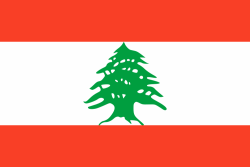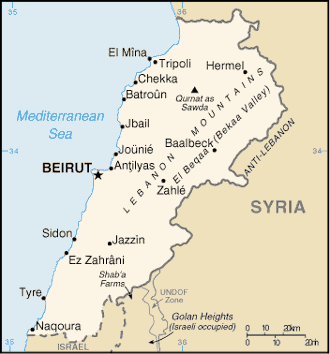Lebanon
Related Categories:
 Flag of Lebanon
Flag of LebanonThree horizontal bands consisting of red (top), white (middle, double width), and red (bottom) with a green cedar tree centered in the white band. |
 Cedars of Lebanon
Cedars of LebanonThroughout antiquity the cedars of Lebanon were prized above all other trees.
www.phoenician.org/
The invention of the alphabet took place in the land of the Phoenicians known today as Lebanon.
www.lebanonembassyus.org/
The Lebanese flag is derived from the French tricolor. The cedar was placed in the white of the French flag.
www.fotw.us/flags/lb.html Lebanon - wikipedia.org
Until the Lebanese Civil War (1975-1990), the country enjoyed relative calm and prosperity, driven by the tourism, agriculture, and banking sectors of the economy. It was considered the banking capital of the Arab world and was widely known as the "Switzerland of the Middle East" due to its financial power.
en.wikipedia.org/
The population of Lebanon comprises various Christian and Muslim sects as well as Druze. No official census has been taken since 1932, reflecting the political sensitivity in Lebanon over confessional (religious) balance. While there is no consensus over the confessional breakdown of the population for this reason, it is safe to say that the Muslim sects as a whole make up a majority, and that Shi'ites, Sunnis, and Maronites are the three largest groups.
About 400,000 Palestinian refugees, some in Lebanon since 1948, are registered with the United Nations Relief and Works Agency (UNRWA). They are not accorded the legal rights enjoyed by the rest of the population.
With no official figures available, it is estimated that 600,000-900,000 persons fled the country during the initial years of civil war (1975-76). Although some returned, continuing conflict through 1990 as well as after the 2006 war sparked further waves of emigration, casting even more doubt on population figures. As much as 7% of the population was killed during the civil war between 1975 and 1990. Approximately 17,000-20,000 people are still "missing" or unaccounted for from the civil war period.
Many Lebanese still derive their living from agriculture. The urban population, concentrated mainly in Beirut and Mount Lebanon, is noted for its commercial enterprise. A century and a half of migration and return have produced Lebanese commercial networks around the globe--from North and South America to Europe, the Gulf, and Africa. Lebanon has a high proportion of skilled labor compared with many other Arab countries.
www.state.gov/r/
Introduction
About
Contact
Symbols in The News
Interpret this Symbol
AAC
African
AI
Alchemy
Alphabets
Ancient
Animal Symbolism
Architecture
Art
Articles
Astrology
Baha'i
Blissymbolics
Blueprint Symbols
Buddhist
Celtic Symbols
Cemetery
Chinese Symbols
Christian
Circle
City
Codes
Color
Conlangs
Crop Circles
Danger
Da Vinci Code
Designing Logos
Dictionaries
Dreams
Education
Egyptian Symbols
Electrical
Emoticons
Find Images
Fonts
Food
Fraternity
Hamsa
Healing
Heraldry
Hermetic
Highway Signs
Hindu
History
Hobo
Holiday
Icons
iConji
Islamic
Jain Symbols
Japanese, Kanji
Jewish
Justice
Law
Literary Symbolism
Mandalas
Map
Masonic
Math, Number
Meaning of Names
Medical
Middle East
Military
Miscellaneous
Money
Music
Mythology
Native American
Playing Cards
Power
Psychology
QiQiiKhu
Reiki
Religious
Runes, Norse
Sacred Geometry
Scientific
Science Fiction
Sorority
Sports
Symbols in the News
Tattoos
ThirteenSymbols
Tree of Life
Ursprache
Videos
Visual Languages
Weather
Web Codes
Wicca
Words
Writing Systems
Braille
Coinherence
Coptic
Cuneiform
Easter Island
Etruscan
Happy Human
Hebrew
Kokopelli
Linear B
Lotus
Love Symbols
Mandorla
Moon Alphabet
Nine Pointed Star
Om
Oz
Phonetic
Scarab Beetle
Silent
Theosophy
Unifon
About
Contact
Symbols in The News
Interpret this Symbol
AAC
African
AI
Alchemy
Alphabets
Ancient
Animal Symbolism
Architecture
Art
Articles
Astrology
Baha'i
Blissymbolics
Blueprint Symbols
Buddhist
Celtic Symbols
Cemetery
Chinese Symbols
Christian
Circle
City
Codes
Color
Conlangs
Crop Circles
Danger
Da Vinci Code
Designing Logos
Dictionaries
Dreams
Education
Egyptian Symbols
Electrical
Emoticons
Find Images
Fonts
Food
Fraternity
Hamsa
Healing
Heraldry
Hermetic
Highway Signs
Hindu
History
Hobo
Holiday
Icons
iConji
Islamic
Jain Symbols
Japanese, Kanji
Jewish
Justice
Law
Literary Symbolism
Mandalas
Map
Masonic
Math, Number
Meaning of Names
Medical
Middle East
Military
Miscellaneous
Money
Music
Mythology
Native American
Playing Cards
Power
Psychology
QiQiiKhu
Reiki
Religious
Runes, Norse
Sacred Geometry
Scientific
Science Fiction
Sorority
Sports
Symbols in the News
Tattoos
ThirteenSymbols
Tree of Life
Ursprache
Videos
Visual Languages
Weather
Web Codes
Wicca
Words
Writing Systems
Braille
Coinherence
Coptic
Cuneiform
Easter Island
Etruscan
Happy Human
Hebrew
Kokopelli
Linear B
Lotus
Love Symbols
Mandorla
Moon Alphabet
Nine Pointed Star
Om
Oz
Phonetic
Scarab Beetle
Silent
Theosophy
Unifon
